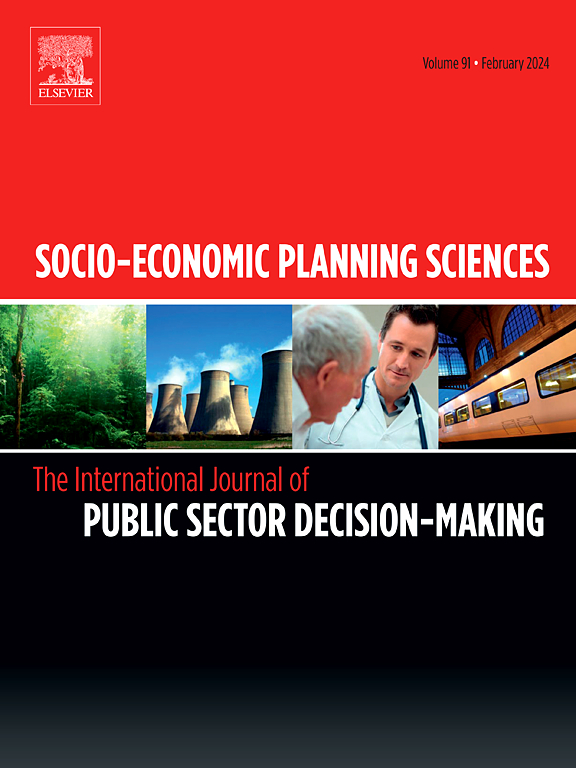The drivers of forest carbon sink density changes in China under forest area heterogeneity: A production-theoretical decomposition analysis
IF 5.4
2区 经济学
Q1 ECONOMICS
引用次数: 0
Abstract
Global temperatures continue to rise, and mitigating climate change has become a common global challenge. As a nature-based solution, forest carbon sink has received high recognition from the international community for its role in mitigating climate change. However, traditional production theory decomposition analysis (PDA) fails to consider regional heterogeneity when exploring the drivers of forest carbon sink. To better formulate strategies for enhancing forest carbon sink based on the specific conditions of each region, this study proposes a PDA method integrated with the meta-frontier model. The new model applied to the forest carbon sink density (FCSD) of 30 provinces in China in 2018. It analyses the driving mechanisms of forest land area inputs, forest pests and diseases infestations, and heterogeneity on the FCSD in state-owned forest areas, southern collective forest areas, and mixed forest areas. The model decomposes them into three primary factors and three substitute factors. The study results indicate the following: (1) After considering heterogeneity, the FCSD shifted from state-owned forest areas toward southern collective forest areas, further indicating that state-owned forest areas still have significant potential for improving forest carbon sink; (2) Further analysis of the two-stage factor substitution effects unrelated to heterogeneity reveals that the varying degrees of substitution among forest land, labor, and capital have different impacts on FCSD; (3) The primary driving factors differ among different forest areas. Results from multiple factors indicate that mixed forest areas perform poorly, further widening forest carbon sink distribution gaps nationwide.
区域异质性下中国森林碳汇密度变化的驱动因素:生产-理论分解分析
全球气温持续上升,减缓气候变化成为全球面临的共同挑战。森林碳汇作为一种基于自然的解决方案,在减缓气候变化方面的作用得到了国际社会的高度认可。然而,传统的生产理论分解分析(PDA)在探索森林碳汇驱动因素时未能考虑区域异质性。为了更好地根据各区域的具体情况制定森林碳汇增强策略,本研究提出了结合元前沿模型的PDA方法。该模型应用于中国30个省份2018年森林碳汇密度(FCSD)。分析了国有林区、南方集体林区和混交林林区林地面积投入、森林病虫害的驱动机制和异质性对FCSD的影响。该模型将其分解为三个主要因素和三个替代因素。研究结果表明:(1)考虑异质性后,森林碳汇由国有林区向南方集体林区转移,进一步表明国有林区仍有显著的森林碳汇提升潜力;(2)进一步分析与异质性无关的两阶段要素替代效应,发现林地、劳动力和资本之间不同程度的替代对FCSD的影响不同;(3)不同林区的主要驱动因素不同。综合多因素分析结果表明,混交林地区碳汇表现不佳,进一步拉大了全国森林碳汇分布差距。
本文章由计算机程序翻译,如有差异,请以英文原文为准。
求助全文
约1分钟内获得全文
求助全文
来源期刊

Socio-economic Planning Sciences
OPERATIONS RESEARCH & MANAGEMENT SCIENCE-
CiteScore
9.40
自引率
13.10%
发文量
294
审稿时长
58 days
期刊介绍:
Studies directed toward the more effective utilization of existing resources, e.g. mathematical programming models of health care delivery systems with relevance to more effective program design; systems analysis of fire outbreaks and its relevance to the location of fire stations; statistical analysis of the efficiency of a developing country economy or industry.
Studies relating to the interaction of various segments of society and technology, e.g. the effects of government health policies on the utilization and design of hospital facilities; the relationship between housing density and the demands on public transportation or other service facilities: patterns and implications of urban development and air or water pollution.
Studies devoted to the anticipations of and response to future needs for social, health and other human services, e.g. the relationship between industrial growth and the development of educational resources in affected areas; investigation of future demands for material and child health resources in a developing country; design of effective recycling in an urban setting.
 求助内容:
求助内容: 应助结果提醒方式:
应助结果提醒方式:


